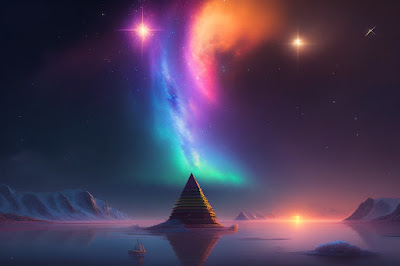Multiverse Theories Explored
Exploring the Multiverse: Unveiling the Theories and Possibilities -
Introduction:
The concept of a multiverse has captivated the imagination of scientists, philosophers, and enthusiasts alike. The idea that our universe might be just one of many parallel universes, each with its own set of physical laws and possibilities, has sparked countless theories and speculations. In this blog, we will step aboard on an exciting journey through the realm of the multiverse, exploring the theories that support its existence and the fascinating possibilities it offers.
Theories of the Multiverse:
Many-Worlds Interpretation:-
The Many-Worlds Interpretation (MWI) of quantum mechanics, proposed by Hugh Everett in the 1950s, suggests that every quantum event gives rise to a branching universe. According to this theory, whenever a quantum measurement occurs, the universe splits into multiple branches, each representing a different outcome. This implies that an infinite number of parallel universes exist, where every possible outcome of any given event is realised.
Bubble Universes and Inflation:-
Inflationary cosmology, a theory proposed by physicist Alan Guth, suggests that shortly after the Big Bang, the universe underwent a rapid expansion. This inflationary period could have created multiple bubble universes, each with its own distinct set of physical properties. These bubble universes, embedded within a larger multiverse, may be continuously forming, expanding, and colliding, leading to an infinite array of universes with different laws of physics.
String Theory and the Landscape:-
String theory, a candidate for a theory of everything, proposes that the fundamental building blocks of the universe are tiny vibrating strings. One of the remarkable aspects of string theory is its prediction of extra dimensions beyond the three spatial dimensions we experience. These additional dimensions may take on a vast number of possible configurations, known as the "landscape" of string theory. Each configuration could correspond to a different universe within the multiverse, with varying physical laws and constants.
Possibilities within the Multiverse:
Different Laws of Physics:-
If the multiverse exists, it implies that other universes may have entirely different laws of physics. This opens up the possibility of universes with different fundamental forces, varying constants, and alternative physical behaviours. Imagining a universe with completely different physical laws challenges our understanding and expands the boundaries of scientific exploration.
Parallel Copies of Ourselves:-
Within the multiverse, there could be parallel universes that closely resemble our own. These parallel copies may contain alternate versions of ourselves, living out different life paths and making diverse choices. The concept of encountering alternate versions of ourselves introduces intriguing philosophical questions about personal identity and the nature of consciousness.
Cosmic Natural Selection:-
Some theories suggest that universes within the multiverse undergo a process of cosmic natural selection. Universes with physical laws and constants that are conducive to the emergence of complex structures like galaxies and life may be more likely to exist and persist. This idea raises the possibility that our universe's fine-tuned conditions for life may not be entirely coincidental but rather a result of a selection process within the multiverse.
Exploring and Interacting with Other Universes:-
While the concept of physically reaching other universes within the multiverse remains highly speculative, some theories propose the existence of "bridges" or "wormholes" that could connect different universes. These hypothetical connections might allow for the exchange of information or travel between parallel universes, opening up mind-bending possibilities for exploration and discovery.
Conclusion:
The notion of a multiverse stretches our understanding of the cosmos and invites us to ponder the vastness of existence. Although the existence of a multiverse remains unproven, the theories and possibilities it presents ignite our curiosity and challenge our conventional notions of reality. Exploring the multiverse allows us to contemplate the boundless potentiality of the cosmos and encourages us to continually push the boundaries of human knowledge.
As we delve deeper into the mysteries of the multiverse, we may uncover profound insights into the nature of our own universe and our place within the grand tapestry of existence. Whether the multiverse remains a fascinating hypothesis or becomes a scientifically validated reality, its exploration will undoubtedly continue to inspire awe and wonder for generations to come.
-Keva



Comments
Post a Comment